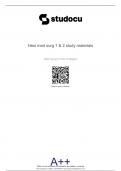Tentamen (uitwerkingen)
Hesi med surg 1 & 2 study materials 100% guaranteed pass.
- Vak
- Instelling
Hesi med surg 1 & 2 study materialsRenal Nursing Interventions ⧫ Assess for and document patient's normal voiding pattern. ⧫ Monitor quality and color of urine. Optimally, urine is straw colored and clear and has a characteristic urine odor. Dark urine is often indicative of dehydration,...
[Meer zien]




